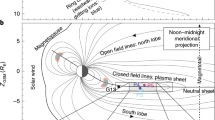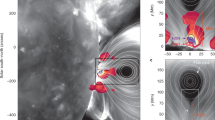Abstract
Violent releases of space plasma energy from the Earth’s magnetotail during substorms produce strong electric currents and bright aurora. But what modulates these currents and aurora and controls dissipation of the energy released in the ionosphere? Using data from the THEMIS fleet of satellites and ground-based imagers and magnetometers, we show that plasma energy dissipation is controlled by field-aligned currents (FACs) produced and modulated during magnetotail topology change and oscillatory braking of fast plasma jets at 10–14 Earth radii in the nightside magnetosphere. FACs appear in regions where plasma sheet pressure and flux tube volume gradients are non-collinear. Faster tailward expansion of magnetotail dipolarization and subsequent slower inner plasma sheet restretching during substorm expansion and recovery phases cause faster poleward then slower equatorward movement of the substorm aurora. Anharmonic radial plasma oscillations build up displaced current filaments and are responsible for discrete longitudinal auroral arcs that move equatorward at a velocity of about 1 km s−1. This observed auroral activity appears sufficient to dissipate the released energy.
This is a preview of subscription content, access via your institution
Access options
Subscribe to this journal
Receive 12 print issues and online access
$209.00 per year
only $17.42 per issue
Buy this article
- Purchase on Springer Link
- Instant access to full article PDF
Prices may be subject to local taxes which are calculated during checkout





Similar content being viewed by others
References
McPherron, R. L. Magnetospheric substorms. Rev. Geophys. Space Phys. 17, 657–681 (1979).
Akasofu, S.-I. Auroral substorms as an electrical discharge phenomenon. Prog. Earth Planet. Sci. 2, 1–21 (2015).
Angelopoulos, V. et al. Tail reconnection triggering substorm onset. Science 321, 931–935 (2008).
Baumjohann, W., Paschmann, G. & Luehr, H. Characteristics of high-speed ion flows in the plasma sheet. J. Geophys. Res. 95, 3801–3809 (1990).
Angelopoulos, V. et al. Statistical characteristics of bursty bulk flow events. J. Geophys. Res. 99, 21257–21280 (1994).
Angelopoulos, V. et al. Electromagnetic energy conversion at reconnection fronts. Science 341, 1478–1482 (2013).
Drake, J. F., Swisdak, M., Cassak, P. A. & Phan, T. D. On the 3-D structure and dissipation of reconnection-driven flow bursts. Geophys. Res. Lett. 41, 3710–3716 (2014).
Nakamura, R. et al. Earthward flow bursts, auroral streamers, and small expansions. J. Geophys. Res. 106, 10791–10802 (2001).
Pontius, D. H. Jr & Wolf, R. A. Transient flux tubes in the terrestrial magnetosphere. Geophys. Res. Lett. 17, 49–52 (1990).
Baumjohann, W. Modes of convection in the magnetotail. Phys. Plasmas 9, 3665–3667 (2002).
Nakamura, R. et al. Plasma flow and magnetic field characteristics near the midtail neutral sheet. J. Geophys. Res. 99, 23591–23601 (1994).
Schödel, R., Nakamura, R., Baumjohann, W. & Mukai, T. Rapid flux transport and plasma sheet reconfiguration. J. Geophys. Res. 106, 8381–8390 (2001).
Baumjohann, W. et al. Substorm dipolarization and recovery. J. Geophys. Res. 104, 24995–25000 (1999).
Birn, J., Nakamura, R., Panov, E. V. & Hesse, M. Bursty bulk flows and dipolarization in MHD simulations of magnetotail reconnection. J. Geophys. Res. 116, A01210 (2011).
Wolf, R. A., Chen, C. X. & Toffoletto, F. R. Thin filament simulations for Earth’s plasma sheet: interchange oscillations. J. Geophys. Res. 117, A02215 (2012).
Panov, E. V. et al. Oscillatory flow braking in the magnetotail: THEMIS statistics. Geophys. Res. Lett. 40, 2505–2510 (2013).
Sergeev, V. A., Chernyaev, I. A., Angelopoulos, V., Runov, A. V. & Nakamura, R. Stopping flow bursts and their role in the generation of the substorm current wedge. Geophys. Res. Lett. 41, 1106–1112 (2014).
Birn, J., Hesse, M., Haerendel, G., Baumjohann, W. & Shiokawa, K. Flow braking and the substorm current wedge. J. Geophys. Res. 104, 19895–19904 (1999).
Kepko, L. et al. Substorm current wedge revisited. Space Sci. Rev. 190, 1–46 (2015).
Angelopoulos, V. The THEMIS mission. Space Sci. Rev. 141, 5–34 (2008).
Auster, H. U. et al. The THEMIS fluxgate magnetometer. Space Sci. Rev. 141, 235–264 (2008).
McFadden, J. P. et al. The THEMIS ESA plasma instrument and in-flight calibration. Space Sci. Rev. 141, 277–302 (2008).
Mende, S. B. et al. The THEMIS array of ground-based observatories for the study of auroral substorms. Space Sci. Rev. 141, 357–387 (2008).
Mann, I. R. et al. The upgraded CARISMA magnetometer array in the THEMIS era. Space Sci. Rev. 141, 413–451 (2008).
Weygand, J. M. et al. Application and validation of the spherical elementary currents systems technique for deriving ionospheric equivalent currents with the North American and Greenland ground magnetometer arrays. J. Geophys. Res. 116, A03305 (2011).
Barron, J., Fleet, D. J. & Beauchemin, S. S. Performance of optical flow techniques. Int. J. Comput. Vis. 12, 43–77 (1994).
Amm, O. & Kauristie, K. Ionospheric signatures of bursty bulk flows. Surv. Geophys. 23, 1–32 (2002).
Hsieh, M.-S. & Otto, A. Thin current sheet formation in response to the loading and the depletion of magnetic flux during the substorm growth phase. J. Geophys. Res. 120, 4264–4278 (2015).
Kubyshkina, M. et al. Time-dependent magnetospheric configuration and breakup mapping during a substorm. J. Geophys. Res. 116, A00I27 (2011).
Vasyliunas, V. M. in Particles and Field in the Magnetosphere Vol. 17 (eds McCormack, B. M. & Renzini, A.) 60–71 (Astrophysics and Space Science Library, 1970).
Wolf, R. A. et al. Estimating local plasma sheet PV5/3 from single-spacecraft measurements. J. Geophys. Res. 111, A12218 (2006).
Panov, E. V., Wolf, R. A., Kubyshkina, M., Baumjohann, W. & Nakamura, R. Anharmonic oscillatory flow braking in the Earth’s magnetotail. Geophys. Res. Lett. 42, 3700–3706 (2015).
Angelopoulos, V. et al. Multipoint analysis of a bursty bulk flow event on April 11, 1985. J. Geophys. Res. 101, 4967–4989 (1996).
Miyashita, Y. et al. A statistical study of energy release and transport midway between the magnetic reconnection and initial dipolarization regions in the near-Earth magnetotail associated with substorm expansion onsets. J. Geophys. Res. 117, A11214 (2012).
Baumjohann, W. & Kamide, Y. Hemispherical Joule heating and the AE indices. J. Geophys. Res. 89, 383–388 (1984).
Hardy, D. A., Gussenhoven, M. S. & Holeman, E. A statistical model of auroral electron precipitation. J. Geophys. Res. 90, 4229–4248 (1985).
Haerendel, G. Poleward arcs of the auroral oval during substorms and the inner edge of the plasma sheet. J. Geophys, Res. 114, A06214 (2009).
Robinson, R. M., Vondrak, R. R., Miller, K., Dabbs, T. & Hardy, D. On calculating ionospheric conductances from the flux and energy of precipitating electrons. J. Geophys. Res. 92, 2565–2569 (1987).
Gjerloev, J. W. & Hoffman, R. A. Height-integrated conductivity in auroral substorms. 1. Data. J. Geophys. Res. 105, 215–226 (2000).
Acknowledgements
We acknowledge NASA contract NAS5-02099 for use of data from the THEMIS Mission and, specifically, for the use of FGM data supported through the German Ministry for Economy and Technology and the German Center for Aviation and Space (DLR) under contract 50 OC 0302. For the GBO/ASIs, we acknowledge S. Mende and E. Donovan, NASA contract NAS5-02099 and the CSA for logistical support in fielding and data retrieval from the GBO stations. The authors gratefully acknowledge AUTUMN, CANMOS, CARISMA, DTU, GIMA, MACCS, McMAC, STEP, THEMIS and USGS for the use of ground-based magnetic field data over Greenland and North America. The work of M.V.K. was supported by RFBR grant 16-05-00470. The work of E.V.P. and R.N. was partly supported by the Austrian Science Fund (FWF) I2016-N20 and by the Seventh Framework European Commission Programme (FP7, project 269198 Geoplasmas). The authors thank O. Amm for helping with ionospheric currents calculations, J. Hohl for helping with editing, and K.-H. Glaßmeier, O. Panova, A. A. Petrukovich, V. A. Sergeev and F. R. Toffoletto for insightful discussions.
Author information
Authors and Affiliations
Contributions
E.V.P. developed the research and did the main part of the data analysis; R.A.W. applied analytical thin filament calculations; W.B. and R.A.W. provided theoretical insight into interpretation of the observational data; R.N. and V.A. contributed to the data interpretation and manuscript preparation; J.M.W. applied the spherical elementary currents (SECSs) method to the ground magnetometer data; M.V.K. applied the AM-03 model to THEMIS data and traced THEMIS probes’ ionospheric footprints; E.V.P. wrote the manuscript, with revisions provided by V.A., W.B., R.N. and R.A.W.; all authors contributed to the discussion of the results and manuscript.
Corresponding author
Ethics declarations
Competing interests
The authors declare no competing financial interests.
Supplementary information
Supplementary information
Supplementary information (PDF 615 kb)
Supplementary Movie 1
Supplementary Movie (MP4 4206 kb)
Supplementary Movie 2
Supplementary Movie (MP4 4054 kb)
Supplementary Movie 3
Supplementary Movie (MP4 400 kb)
Rights and permissions
About this article
Cite this article
Panov, E., Baumjohann, W., Wolf, R. et al. Magnetotail energy dissipation during an auroral substorm. Nature Phys 12, 1158–1163 (2016). https://doi.org/10.1038/nphys3879
Received:
Accepted:
Published:
Issue Date:
DOI: https://doi.org/10.1038/nphys3879
This article is cited by
-
Explosive Magnetotail Activity
Space Science Reviews (2019)
-
A diagnosis of the plasma waves responsible for the explosive energy release of substorm onset
Nature Communications (2018)



